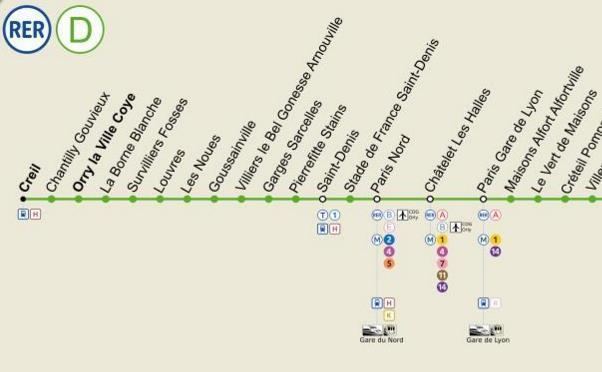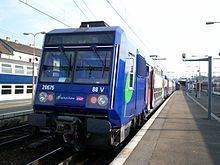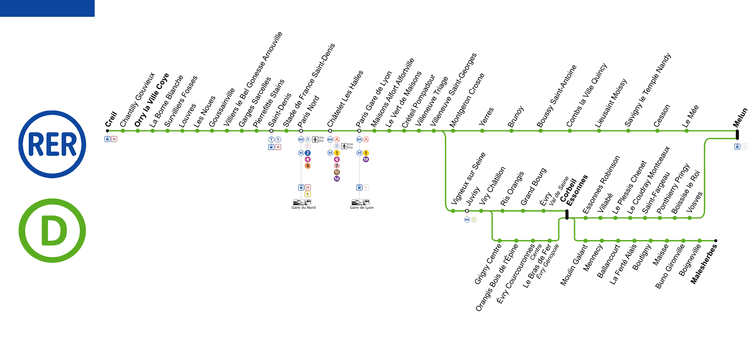Line length 190 km (120 mi) | Stations 59 | |
 | ||
Ridership 145,000,000 journeys per year Opened 1987
(last extension in 1996) Track gauge 1,435 mm (4 ft 8 ⁄2 in) Rolling stocks SNCF Class Z 5300, SNCF Class Z 20500 | ||
Rer d paris
The RER D is one of five RER rapid transit system lines serving Paris, France. It connects Orry-la-Ville and Creil in the north to Melun, Corbeil-Essonnes and Malesherbes in the south, passing through the heart of Paris.
Contents
- Rer d paris
- Chronology
- Conception
- Inauguration
- An interconnected line
- A near miss
- The RER D affair
- A master plan set in motion
- Delays
- References

Opened in stages from 1987 to 1996, it is the longest RER line by distance, and the busiest SNCF line in France, carrying up to 550,000 passengers and operating 440 trains each working day. Almost all of the line is located in the Île-de-France region, that is, within the jurisdiction of the Île-de-France Transport Union (STIF), but the some of the branch line ends at the north and south are outside this region. Due to a high rate of incidents and social issues, the line is sometimes colloquially known as the "RER poubelle" (trash line).

Line D also links Gare du Nord with Gare de Lyon via Châtelet – Les-Halles. The northern section of Gare du Nord opened in the late 1980s; a dedicated tunnel opened in 1995 to connect it to the SNCF network south of Gare de Lyon, part of which was transferred to the RER.

Chronology
Conception

Initially, the "métro régional", the ancestor to the RER, was conceived of three lines, one going from east to west (the future RER A), a new line built from existing lines (the future RER C), the extension of the Ligne de Sceaux and with its interconnection with an SNCF line, along with a supplementary interconnected north-south (the future RER D). The operation of renovating "les Halles" gave the occasion to build Châtelet-Les Halles with a cut-and-cover method, in order to reduce costs.

Initially, the new RER D was meant to share with the RER A between Paris-Gare de Lyon and Châtelet-Les Halles. But, RATP, the company who runs the RER A, objected to such an operation as the number of passengers using the RER A was growing and required running extra trains on the RER A. It was decided that instead, each lines must have its own platforms, in which the RER A at the Gare de Lyon has its tracks at lower level of the underground station, with the future RER D on the upper level. The RER D tracks at Paris-Gare de Lyon have four tracks and being above the RER A tracks, allowed "platform to platform" transfers vertically, a Japanese invention.
Inauguration
On 27 September 1987, the RER D was officially created, by extending existing suburban trains from Villiers-le-Bel to Gare du Nord, towards Châtelet-Les Halles. Initially 19 km (12 mi) long, it was equipped with bi-current Z 8800 stock trains, while newer Z 20500 stock trains were still being built. At Châtelet-Les Halles station, the RER D terminated on the three central tracks, already built from the conception of Châtelet-Les Halles station.
In 1988, existing suburban trains terminating at Goussainville now integrate with the RER D. On the same year, the first bi-mode Z 20500 trains are in service. They were initially composed of 4 cars until the north-south interconnection was inaugurated in 1995, when they became 5-car trains (where they're coupled to make 10-car trains).
In September 1990, the RER D again extended north to Orry-la-Ville. At the same time, one-man operation started on the RER D.
An interconnected line
Finally, on 11 September 1995, the north-south interconnection of the RER D was put into service by building a dedicated 2.5 km (1.6 mi) long tunnel between Châtelet-Les Halles and Paris-Gare de Lyon.
In 1996, the RER D was extended south from La Ferté-Alais to Malesherbes. On 15 January 1998 for the 1998 FIFA World Cup, St-Denis – Stade de France station opened, in order to serve the Stade de France.
A high number of incidents, from a social and service point of view, have brought the term "RER poubelle" ("RER trash" in French), often used by its users, and even its staff. Assaults are frequent and unpunctuality is the highest in the Transilien network, with the number of late trains going from 9.9% to 14.1% between 1994 and 1995.
A near miss
On 20 September 2003, an unusual incident occurred near Villeneuve-Triage station. A southbound train stopped at 18:50 on the central track near the station due to an incident. Passengers aboard were invited to step off the train by the left, as track 2M has been neutralised by the regulators. However, due to a misuse of the alarm signal by nervous passengers, some doors opened on the right. Ignoring the driver's orders, numerous passengers stepped off on the right, and were confronted with a northbound train, travelling at around 110 km/h (70 mph).
The driver of the train had the time to activate his emergency brakes and slowed the train to around 70 km/h (45 mph), which permitted to passengers to brace against the stopped train or jump into the ditch. Thankfully, no one was injured. This near miss, filmed by a passenger with a mobile phone, was broadcast the night of the incident, and created a large controversy.
The "RER D" affair
On 9 July 2004, a presumed anti-semitic assault provoked a large stir in France, as well as a political and media frenzy with immediate declarations from the Ministry of the Interior Dominique de Villepin and the President of France Jacques Chirac. However, the allegations were proven false after the investigation, as the person behind the presumed assault suffered from pathological lying. The affair then provoked a controversy on the treatment of information by the media.
A master plan set in motion
On 22 November 2006, the STIF has approved a master plan for the RER D, in order to establish short, mid and long term goals for the reliability of the RER D.
On 29 January 2007, the first renovated Z 20500 train was presented, the first out of 137 trains. Renovated trains feature a new blue livery, uniform 2+3 seats, new lighting and new floor covering. The renovation programme costs over €100,000,000.
Delays
The RER D is often seen in Paris as the most unpunctual railway line in the RER network. This unpunctuality is partially due to the tunnel the RER B and RER D lines share between Châtelet - Les Halles station and Gare du Nord station, where even a small delay of a few seconds on either lines can cause catastrophic delays and trains to be cancelled. The effects of this mean regular commuters of the RER D are used to trains being cancelled or late daily.
